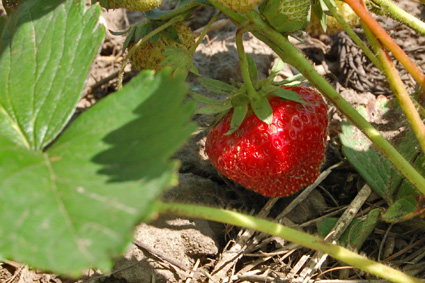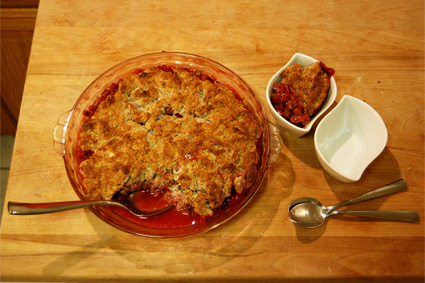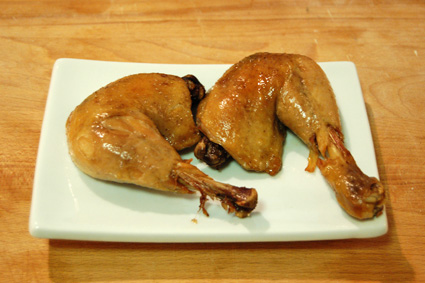
'Tis the season for strawberries, that sure sign of summer's imminent arrival. Local strawberries, of course, and preferably organic ones. I don't care if California berries are available virtually year-round; if the tips aren't red when they're picked, I'm not interested. And the shelf life of a ripe strawberry1 isn't enough to get them very far.
We're just shy of pick-your-own strawberry season on the farm - it starts on Friday - but being an employee means I get the perk of stopping by to harvest as the urge strikes. So, on Saturday afternoon, Sharon and I picked a little over two quarts' worth of ripe berries to enjoy for the week. Or as long as they last.

They're great just brushed clean - washed only when necessary - or macerated in sugar and booze, be it wine, rum or Grand Marnier. Or, in our case, the Triple Sec that's hanging about from the last time we made margaritas. Add a little of your favorite rich, dairy goodness - cream's traditional, but there's nothing wrong with yogurt, a soft cheese or ice cream - and it's about as good as dessert gets.
Of course, when you also have a few pounds of fresh rhubarb lying about, a little extra effort's highly rewarding. Though most people seem to think of the strawberry-rhubarb combination2 first and foremost, their seasons don't overlap for long, at least around here. The flavors complement each other well, but it's a short window in late spring.
So, when the chance is there, it's best to run with it. Saturday night, with fresh berries and rhubarb, it was time for cobbler. Yes, pies are nice, but my crust-making skills are marginal. And I wanted something with more crunch to it than shortcake or clafoutis. What could possibly be better - or easier - than fruit cooked with free-form biscuits? That's all that a cobbler is - fruit and sugar on the bottom, with biscuits baked on top.

This recipe's swiped (nearly) directly from Joy, but it was good right out of the oven, a day later on a picnic, and so easy that it's worth making again.
Strawberry Rhubarb Cobbler* * * * *
Makes six to eight servings
IngredientsCornmeal cobbler biscuit dough:
- Cornmeal cobbler biscuit dough (below)
- 1¼ pounds rhubarb, sliced into ¼-inch pieces
- 1 pint strawberries, hulled and cut into bite-size pieces
- ½ cup sugar
- 2 tablespoons flour
Directions
- 1 cup all-purpose flour
- 1/3 cup cornmeal
- 2 tablespoons sugar
- ½ tablespoon baking powder
- ½ teaspoon salt
- 5 tablespoons cold, unsalted butter
- ½ cup cold milk
- Preheat the oven to 375°F. Mix the rhubarb, strawberries, sugar and flour together in a bowl, and allow to sit for at least fifteen minutes. Pour the mixture - juices and all - into a 9-inch pie pan, an 8x8-inch baking pan, or any dish of similar size.
- Prepare the biscuit dough, as follows: whisk together the flour, cornmeal, sugar, baking powder and salt in a bowl. Using a pastry cutter or a pair of knives, cut in the butter until there are chunks no larger than small peas. Add in the milk, stirring just until the dough comes together. Knead against the side of the bowl a few times until any loose pieces are incorporated.
- On a lightly floured board, roll or pat out the cobbler dough until roughly the shape of the baking dish. (Alternately, you can cut it into shapes, make a lattice, or simply pinch off walnut-sized wads.) Set on top of the fruit mixture - cut a few steam vents if covering the fruit completely - and dust with sugar.
- Bake until the juices are bubbling and the dough is golden brown, approximately 45 minutes. All to cool for 15 minutes before serving, either on its own or with some vanilla ice cream.
1Which is still more than ripe raspberries, another seasonal delight that's unparalleled straight from the berry patch.
2Strawberry-rhubarb pie being the usual, but I'm partial to the strawberry-rhubarb bars from Cress Spring Bakery. I've been enjoying one nearly every week for the past month and a half.







